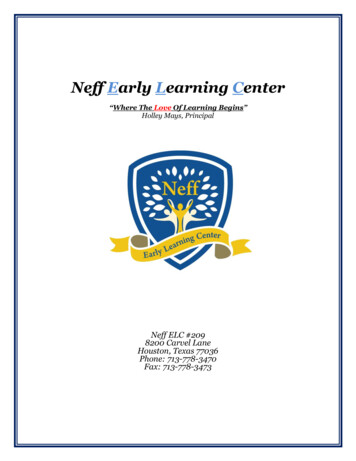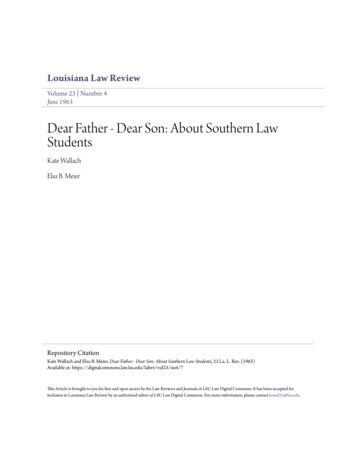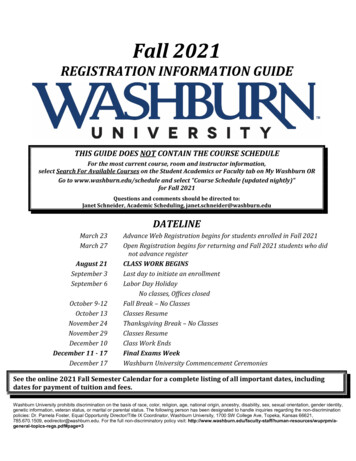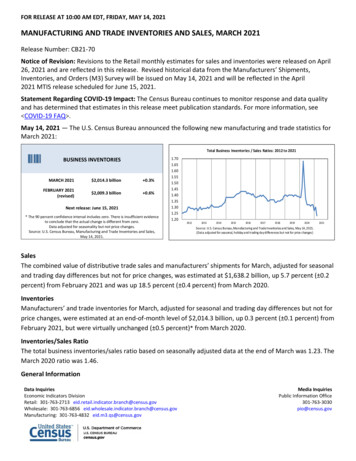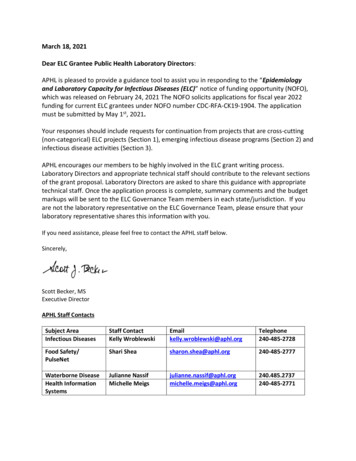
Transcription
March 18, 2021Dear ELC Grantee Public Health Laboratory Directors:APHL is pleased to provide a guidance tool to assist you in responding to the “Epidemiologyand Laboratory Capacity for Infectious Diseases (ELC)” notice of funding opportunity (NOFO),which was released on February 24, 2021 The NOFO solicits applications for fiscal year 2022funding for current ELC grantees under NOFO number CDC-RFA-CK19-1904. The applicationmust be submitted by May 1st, 2021.Your responses should include requests for continuation from projects that are cross-cutting(non-categorical) ELC projects (Section 1), emerging infectious disease programs (Section 2) andinfectious disease activities (Section 3).APHL encourages our members to be highly involved in the ELC grant writing process.Laboratory Directors and appropriate technical staff should contribute to the relevant sectionsof the grant proposal. Laboratory Directors are asked to share this guidance with appropriatetechnical staff. Once the application process is complete, summary comments and the budgetmarkups will be sent to the ELC Governance Team members in each state/jurisdiction. If youare not the laboratory representative on the ELC Governance Team, please ensure that yourlaboratory representative shares this information with you.If you need assistance, please feel free to contact the APHL staff below.Sincerely,Scott Becker, MSExecutive DirectorAPHL Staff ContactsSubject AreaInfectious DiseasesStaff ContactKelly 40-485-2728Food Safety/PulseNetShari Sheasharon.shea@aphl.org240-485-2777Waterborne DiseaseHealth InformationSystemsJulianne NassifMichelle rg240.485.2737240-485-2771
Important Changes: Budget Period (BP2) application process was streamlined last year and will continue this year forBP3. Workplan milestones monitoring that has been done quarterly in REDCap will continue toserve in meeting the budget period progress reporting requirements.Please include a brief statement at the beginning of the “Implementation Plan” for any/allactivities that have been impacted due to the COVID-19 response.Thirty-two million dollars in new funding is available for wastewater surveillance for SARS CoV-2,including building capacity for laboratory testing, in Section II, F.APHL maintains a list of manufacturer discounts for public health on our website: Public HealthPricing ListC2: Data Modernization: APHL has reiterated many of the DMI suggested activities from our2020 guidance to provide general guidance and information based on the original intent andfundamental focus areas of DMI. However, PHLs are strongly advised to work with their ELCproject officer and the ELC HIS team (edx@cdc.gov) to ensure alignment of these resources withrequired activities funded under the Coronavirus Response and Relief Act, 2021.Section 1: Cross-cutting Emerging Infectious Disease Capacity, Systems andLeadership(Guidance includes only sections relevant to the laboratory)Attachment A: Cross-Cutting Epidemiology and Laboratory Capacity (p. 9-22) 64 Awards; average of 345,313 per award, total availability of funds: 22,100,000To build and maintain epidemiological and laboratory capacity, funds should be used forpersonnel, supplies, travel, systems, statistical software and other requisite.APHL suggests that you include activities that will improve integration with your healthdepartment partners, will broadly improve your laboratory practice, and will benefit testingactivities across ELC-funded programs. Although activities are combined be sure to submit aSEPARATE LABORATORY BUDGET. Additional 5,400,000 to support for AMD:1. AMD-related workforce development through training at the state and local level fortraining leads or training participantsTraining leads: Approximate number of awards: 7; average of 20,000 to 150,000Training participants: Approximate number of awards: 40 to 64, average 3,000 to 10,0002. Bioinformatics supportApproximate number of awards: 7; average of 50,000 to 150,0003. Support state and local health department initiatives to extend the use of AMDtechnologiesApproximate number of awards: 20 to 40; average of 15,000 to 100,000Page 2 of 34
CDC may have additional funding beyond what was detailed in the original continuationguidance. All eligible laboratories should condsider proposing activities in this section andconsider proposing greater requests than typical. CDC is looking to focus funding requests toexpand workforce and increase sequencing capacity so prioritize requests for additional staff andequipment that will increase capacity or throughput. Please note that these additional AMDfunds may not be awarded through this funding mechanism.Strategies and Activities:Area A: Surveillance, Detection and Response1) Enhanced Workforce CapacityAPHL Suggested ActivitiesConsider your need for training in disease areas traditionally funded through ELC or biosafety. Alist of upcoming training opportunities offered by APHL’s Training Program can be found here(Strategy 1c) Consider including travel to other public health laboratories to receive training. Consider AMD workforce there are two tiers that applicants may apply to - requests under bothtiers will be considered: AMD Workforce: All laboratories request funding for training for current staff including travel for staff toattend regional trainings held by workforce training leads. Other costs related to AMDtraining and workforce development with accompanying justification may also beconsidered. CDC will consider support for travel to conferences including InFORM 2022. Dates andlocation are TBD. AMD Regional Workforce Development Training Lead: Given the uncertainty of travel, training lead laboratories should consider askingfor additional funding to support technologically advanced online training andother technology that would assist with providing services around training AMD Regional Bioinformatics Regional Resource: Laboratories interested in providingbioinformatics resources and support to other public health laboratories in their regionshould apply. Funding requests should include: One full-time bioinformatics staff member, who serves as the bioinformaticssubject matter expert for the entire region. Staff may be contracted through an academic partner or otherorganization; funding may be requested for the time, the costs ofacquiring and implementing contract services for the personnel member. Travel costs associated with the BRR providing consultation throughout thedefined region, including on-site visits with regional public health laboratoriesand health departments. Successful activities of current BRRs include: hosting online classes, providingvirtual machines and computing resources, one-on-one visits with PHLs,supporting genome assembly and analysis and ad hoc technical services. In Page 3 of 34
addition to bioinformatics expertise, the resource supports also providedassistance in communication with PHL information technology departments.Laboratories without in-house bioinformatics expertise have also contractedwith academic institutions to help provide technical expertise.2) Enhance Investigation and outbreak responseConsider the costs associated with setting up or supporting an existing courier system for thetransport of ELC-funded organisms.Consider funds needed to implement recommendations in the Third Edition CIFOR FoodborneDisease Outbreak Response Guidelines published in fall 2020.Consider requesting funds to implement the CIFOR Outbreaks of Undetermined Etiology (OUE)GuidelinesWork with epidemiology partners to identify needs to sustain or implement testing to supportoutbreak response. 4) Strengthen laboratory testing for responseAPHL Suggested Activities Implement, sustain or enhance testing to support infectious disease surveillance or outbreakresponse. When developing these activities consider the following:A number of nucleic acid extraction platforms commonly used in public health laboratories willbe sun setting in coming years. Consider your need to update extraction platforms and consultthis table for information on which platforms are sun-setting and which CDC assays have beencleared or evaluated on various models.APHL maintains a list of manufacturer discounts for public health on our website: Public HealthPricing List.Consider your need for miscellaneous laboratory supplies such as packaging and shippingcontainers (plus shipping costs), viral transport media, culture media, PPE (including N-95s),commercial PCR reagents, nucleic acid extraction chemistries, pipettes/pipet tips.AMD Capacity Building:This year ALL LABORATORIES are encouraged to submit a budget to build AMD capacity.Laboratories are encouraged to include requests for staffing, equipment and computinginfrastructure required to support robust and flexible sequencing capacity. These requests maynot be awarded with this continuation request but additional supplemental opportunities maybe forthcoming. Laboratories are encouraged to request funding for liquid handlers and other equipment tosupport automation. Laboratories are encouraged to request funding for additional sequencers and otherinstrumentation to increase the amount of sequencing capacity. Requests around additional supplies and equipment to aid in the set-up of AMD technologywith little to no existing infrastructure.Page 4 of 34
Funding requests for additional laboratory staffing will also be considered.Requests for additional computing infrastructure needs either local or cloud resources arealso encouraged.5) Improve laboratory coordination and outreach to improve efficiency Consider establishing partnerships with clinical and commercial laboratories to develop orenhance cross-cutting specimen and data sharing networks to enhance and create efficienciesamongst existing surveillance activities. Especially consider the benefit for influenza and otherrespiratory pathogens, antimicrobial resistant isolates, Culture independent diagnostic tests, andfoodborne specimens/ isolates. Consider including activities that will enhance partnership formultiple pathogens.Attachment B: ELC Leadership, Management and Administration (p. 22-25)Estimated number of awards for ELC Annual Meeting: 64; average per award: 6,000 for travelEstimated number of awards for Personal: 43; average per award: 90,000 for personnel and associatedcostsEstimated number of awards for ICEID: 64; average per award: 1,550 per traveler; 4,650 total for 3travelersConsider requesting funds to support a Lab-Epi Connector (an epi liaison) that is housed at yourlaboratory. This person would enhance and help support ongoing communication between lab and epiand clinical laboratory partners. (Strategy 1b or 1c)Applicants are required to include travel support to attend the 2022 ELC Annual meeting in Atlanta.Applicants should request assistance to support travel to the March 2022 International Conference onEmerging Infectious Diseases (ICEID) to be held March 6-9, 2022 in Atlanta, GA.Attachment C: Health Information Systems Capacity (p. 26-34) 64 Awards; average of 438,000 per award, total availability of funds: 28,000,000Strategy 1: Advance Electronic Data Exchange - Activity D: Advance electronic data exchange for PublicHealth LaboratoriesStrategy 2: Sustain and enhance information systems. Activity A: Maintain existing information systemsand Activity Cii: LIMSAPHL Suggested Activities Consider requesting funds to attend the following conferences or meetings: Request additional funds (above those required under Attachment B) for Informatics leads toattend the 2022 ELC Annual meeting in Atlanta. 2021 APHL Annual Meeting NACCHO 360/Public Health Informatics, Information Technology, and Surveillance (PHIITS)Conference, June 29 - July 1 2021, Detroit, MI. https://www.nacchoannual.org/home.Page 5 of 34
2021 Council of State and Territorial Epidemiologists (CSTE) Annual Meeting, June 13-172021, Virtual Conference. https://www.csteconference.org/LOINC Laboratory Conference: https://loinc.org/meetings/ American Health Information Management Association (AHIMA) Health Data andInformation Conference, September 20-22, 2021 Virtual Conferencehttps://conference.ahima.org/ Healthcare Information and Management Systems Society (HIMSS) Annual Conference &Exhibition 2021, August 9 - 13, 2021, Las Vegas, NV https://www.himss.org/globalconference Ensure resources are available to review current and new informatics policies and distributedguidance to ensure PHLs stay up to date on changing regulations and expectations such as the21st Century Cares Act. Consider requesting funds for membership dues or rights to maintain access to relevantInformatics data exchange standards such as Health Level 7 (HL7). Consider requesting funds to retain or hire a laboratory interoperability program manager as thePHL liaison to the legal department, information security groups, and agency leadership. Thisresource would be responsible for coordinating and leading prioritization efforts by analyzing currentinformatics activities, and identifying resource gaps to support ELC activities. This position could be ashared resource between the public health agency and laboratory to enhance epi-lab coordination Consider requesting funds to retain or hire a laboratory interoperability technical lead. This resourcecoordinates the plan of action for establishing and maintaining laboratory data exchangecapabilities for ELC focus activities. Serving as the PHL liaison to the information technologydepartment, system vendors, data exchange partners, national standards groups and organizations,APHL technical assistance teams as well as internal laboratory and epidemiology subject matterexperts. Consider funding to support a PHL wide HIPAA security risk assessment, analyzing currentadministrative, physical, and technical safeguards. d-hipaa/security-risk-assessment-tool Request funding to maintain access to the skills and tools necessary to map, create, validate,maintain and enhance standardized laboratory vocabulary code sets and LIMS configuration such as: LOINC to Vendor IVD Test Result (LIVD) mapping standards to ensure the proper codes areassigned when configuring or updating laboratory tests within information systems. IHE Laboratory Analytical Workflow (LAW) profile: .ihe.net/uploadedFiles/Documents/PaLM/IHE PaLM TF Vol2b.pdf:Implement either in the LIMS or via a middleware to support a standard interface tomultiple instruments. When purchasing new instruments, PHLs should assess whether thevendor supports the LAW profile. Research skills and importance of adopting HL7 FHIR Resources in anticipation ofmodernization initiatives: ge 6 of 34
Request funding to maintain access to the skills and tools necessary to properly format, route andtransmit laboratory data to support inter and intra jurisdictional data exchange needs. PHLs shouldconsider costs of tools and skills necessary to advance data transport and routing activities such as: Implementing data validation tools to support enhanced data completeness, timeliness, andspecificity. Impact: by applying standard definitions and business rules within the logicalsystem architecture via an integration broker, a front-end validator can prepopulate tables,ensure data transparency, require that key fields are populated, automatically flag messageinaccuracies, and improve the overall quality of processed data. Data Integration Engines: PHL should assess access to and availability of shared dataintegration engine expertise and tools. The lab should assess upcoming projects associatedwith data exchange and to determine funding is required for additional expertise orintegration tool licenses to ensure PHLs have the access they need to meet project goals. Consider requesting funds to review and expand message data transport options beyondPHINMS. Options include- web services, Direct, SFTP, S3 and/or other protocols asappropriate. Technical assistance to support these different transport options may beavailable upon request through the APHL technical assistance program. Maintain current CDC program data feeds and participate in efforts to enhance the quality andcompleteness of these data including: PHLIP: Electronic Laboratory Surveillance Feed from laboratories to CDC in support ofrespiratory routine and outbreak test results (Influenza, NREVSS data, SARS-CoV-2,VPD messaging for regional PHLs). Migrate PHLIP reporting to the current HL7 2.5.1 message standard Capture ILINet provider information and other epidemiologically importantinformation in LIMS, and add to PHLIP message Reporting non-influenza respiratory virus surveillance data automaticallythrough PHLIP to replace manual reporting to the National Respiratory andEnteric Virus Surveillance System. ARLN: Implementation and continued maintenance of HL7 messaging to CDC usingthe Data for Action on Antibiotic Resistance Threats (DAART) platform APHL Technical Assistance is available to assist with message upgrades,enhancements, and data transport efforts. For more information about technicalassistance or for access to the PHLIP or ARLN encoding guidelines, please email theInformatics Help Desk at informatics.support@aphl.org.PHLs are strongly advised to work with their ELC project officer and the ELC HIS team (edx@cdc.gov)to ensure alignment of these activities with required activities funded under the CoronavirusResponse and Relief Act, 2021 and Attachment C2: Data Modernization.The PHL required activities outlined under CARES Act supplemental dollars include: Employ a well-functioning Laboratory information Management System (LIMS) to support efficientdata flows within the PHL and its partners. Employ a well-functioning Laboratory information Management System (LIMS) to support efficientdata flows within the PHL and its partners. Ensure ability to administer LIMS Interface diagnostic equipment to directly report laboratory results into LIMSPage 7 of 34
Deploy a web portal in place to support online ordering and reporting. Integrate the web portalinto the LIMS Enhance laboratory test ordering and reporting (ETOR) capability* *Opportunity: During this budget period, the APHL informatics program will focus heavily onstandards-based Electronic Test Order and Result in alignment with data modernization goals toimprove the timeliness, flexibility, and mobility of data, while reducing the financial and security risksof implementing local solutions. The Informatics Program is currently conducting a landscape analysis of ETOR capabilities – ifyou have not already participated, please reach out to Rachel Shepherd:Rachel.shepherd@aphl.org. The assessment focuses on the capacity and capability areasneeded to meet ETOR data modernization goals. APHL and CDC will use these assessment datato identify ETOR-related funding opportunities and APHL technical initiatives to supportmember laboratories. Through the APHL/CDC cooperative agreement and based on stakeholder input, the Informaticsprogram will develop a technical assistance model and deploy a set of shared cloud-based toolsand resources to support a common standards based ETOR initiative focused on dataconnectivity, routing, and vocabulary management services through the AIMS platform. (seeAttachment C: Health Information Systems Capacity, Strategy 2: Sustain and enhance informationsystems, Activity Cii: LIMS: Enhance system to enable the automated processing and use of HL7 electronictest orders that are received and to create HL7 test orders and Attachment C2: Data Modernization,Strategy 2, Activity 2b: “Accelerate improvements to data quality, exchange, management, and use”.PHLs interested in participating in and contributing to a common model for PHL standardsbased ETOR are encouraged to contact the informatics program: informatics@aphl.orgAttachment C2: Data Modernization (p. 35-41) 64 awards, average of 195,000 per award, total availability of funds: 12,500,00AREA A: Accelerating Data ModernizationExternal Links and Resources CDC’s public health data strategy and IT transformation effortsCDC DMI Logic ModelCDC DMI Goal InfographicCDC IT Strategic Plan (2019-2021)CDC Open TechnologyAPHL Informatics ProgramAPHL Health IT Training InformationAPHL Informatics Competencies to ELC crosswalk- not specific to C2Informatics Self Assessment Tool pdf versionH.R.5321 - Public Health Infrastructure Modernization Act of 2019Healthy People 2020 alignment: Health Communication and Health Information TechnologyHealthy People 2020 alignment: Public Health InfrastructureOverview/Information: APHL’s Informatics program and the Informatics committee is committed to supporting the datamodernization initiatives of our members and federal partners and is beginning to stand up technicalPage 8 of 34
and programmatic initiatives that will benefit and enhance these efforts. As such, PHLs shouldconsider assigning both a programmatic and technical point of contact to serve as liaisons to theAPHL informatics program.The activities funded under Data Modernization are not limited to infectious disease program areas.PHLs should identify holistic, innovative approaches to advance laboratory data managementworkforce, systems, tools, and processes and are encouraged to review and link evaluation measuresand outcomes to the overall CDC Data modernization logic modelAPHL has reiterated many of the DMI suggested activities below from our 2020 guidance to providegeneral guidance and information based on the original intent and fundamental focus areas of DMI.However, PHLs are strongly advised to work with their ELC project officer and the ELC HIS team(edx@cdc.gov) to ensure alignment of these resources with required activities funded under theCoronavirus Response and Relief Act, 2021. The PHL required activities outlined under supplementaldollars include: Employ a well-functioning Laboratory information Management System (LIMS) to support efficientdata flows within the PHL and its partners. Employ a well-functioning Laboratory information Management System (LIMS) to support efficientdata flows within the PHL and its partners. Ensure ability to administer LIMS Interface diagnostic equipment to directly report laboratory results into LIMS Deploy a web portal in place to support online ordering and reporting. Integrate the web portalinto the LIMS Enhance laboratory test ordering and reporting (ETOR) capability* *Opportunity: During this budget period, the APHL informatics program will focus heavily onstandards-based Electronic Test Order and Result in alignment with data modernization goals toimprove the timeliness, flexibility, and mobility of data, while reducing the financial and security risksof implementing local solutions. The Informatics Program is currently conducting a landscape analysis of ETOR capabilities – ifyou have not already participated, please reach out to Rachel Shepherd:Rachel.shepherd@aphl.org. The assessment focuses on the capacity and capability areasneeded to meet ETOR data modernization goals. APHL and CDC will use these assessment datato identify ETOR-related funding opportunities and APHL technical initiatives to supportmember laboratories. Through the APHL/CDC cooperative agreement and based on stakeholder input, the Informaticsprogram will develop a technical assistance model and deploy a set of shared cloud-based toolsand resources to support a common standards based ETOR initiative focused on dataconnectivity, routing, and vocabulary management services through the AIMS platform. (seeAttachment C: Health Information Systems Capacity, Strategy 2: Sustain and enhance informationsystems, Activity Cii: LIMS: Enhance system to enable the automated processing and use of HL7 electronictest orders that are received and to create HL7 test orders and Attachment C2: Data Modernization,Strategy 2, Activity 2b: “Accelerate improvements to data quality, exchange, management, and use”.PHLs interested in participating in and contributing to a common model for PHL standardsbased ETOR are encouraged to contact the informatics program: informatics@aphl.orgPage 9 of 34
Strategy 1: Understand, coordinate, and lead data modernization efforts in the jurisdictionActivity 1a: Lead and coordinate data modernization efforts in the health jurisdictionApplicants must designate an individual or group of people responsible for leading data modernizationefforts throughout the budget period. Applicants may assign a single data modernization lead or choosea team approach to meet this requirement.Activity 1b: Document and understand workforce, data, and health information system needs andopportunities Activity 1.b.i focuses on gaining situational awareness of laboratory informatics capacity andcapabilities by documenting and baselining current strengths, weaknesses and gaps acrosstechnologies, infrastructure, policies and procedures and skill sets. The outcomes of activity 1.b.i will inform activity 1.b.ii which focuses on the development of a datamodernization roadmap that describes the future or desired state of laboratory information systemsand workforce capabilities across the organization. This strategic roadmap should identify priority improvements, and value-add initiatives that targetspecific needs within the context of other national, interstate and intrastate modernization efforts. Consider requesting funds to conduct or expand a comprehensive analysis to assess the function,utility, and application of information systems, IT infrastructure, software packages, standardsadoption, and tools across all laboratory workflows and business processes: Test Requests and Sample Receiving Specimen and Sample Tracking/Chain of Custody Lab Information Management Systems (LIMS) across the enterprise- Legacy and newtechnologies Test Results and Instrument Interfacing/Integration Report Preparation and Distribution Data Analysis, Knowledge Management Interoperability and Data Exchange Data Repositories Consider requesting funds to document and prioritize gaps and inefficiencies that must be addressedto meet the data modernization goals of creating scalable, modular, and sustainable public healthdata solutions that take advantage of shared services, and cloud computing strategies. Examplesinclude: Outdated IT infrastructure and system components Inefficient, outdated or ineffective technologies Data availability or quality issues Underutilized technology Gaps in technology adoption Access to necessary tools (such as data integration engines) Risks to continuity of operations and surge capacity Missing, unclear or restrictive policies and proceduresPage 10 of 34
Consider retaining expertise to conduct an overall assessment of current laboratory informaticsworkforce competencies across strategic, operational, and technical roles, documenting strengths,weaknesses, and gaps. Consider conduction detailed job analysis activities to validate the key competencies and relatedconcepts, skills, knowledge, and tools of those critical positions necessary to manage, implement,support, and maintain modernized laboratory informatics services. Although not inclusive, applicantsmay find useful information in this spreadsheet that maps informatics competencies to general ELChealth Information System Capacity (C1) goals APHL Informatics Competencies to ELC crosswalk Consider the use and applicability of the APHL Informatics Self-Assessment Tool (pdf or online) tosupport laboratory assessment activities. Please reach out to Rachel Shepherd(rachel.shepherd@aphl.org) for access to this tool. Consider requesting support for specific time-bound staff augmentation or targeted support throughthe Informatics Technical Assistance Program supported by CDC. All requests must be submitted toedx@cdc.gov for review and approval.Strategy 2: Accelerate data and health information system modernizationActivity 2a: Implement workforce enhancements to accelerate data modernization Consider requesting funding to send key staff to relevant conferences and trainings to fill an identifiedskill gap to support current or future modernization initiatives. Applicants may find ideas or relevantinformation on this compiled list of resources: APHL Health IT Training List Leverage existing laboratory consortiums and consider requesting travel and meeting costs to conveneand discuss interstate coordination and peer-to-peer informatics learning opportunities. Consider requesting support for specific time-bound staff augmentation or targeted support throughthe APHL Informatics Technical Assistance Program supported by CDC. All requests must be submittedto edx@cdc.gov for review and approval. Consider requesting funds to develop basic Informatics training for PHL staff using current andupcoming materials co-developed by CDC and APHL. Introduction to Laboratory Informatics Course: Life of a Specimen Introduction to Laboratory Informatics Course: Life of a Result Competency Guidelines for Public Health Laboratory Professionals. See Table 11 for Informaticsdomain and Table 14 for Bioinformatics u6401a1.htm#tab14Activity 2b. Accelerate improvements to data quality, exchange, management, and use Applicants are highly encouraged to request funding to support innovative, forward thinking projectproposals to support laboratory data modernization goals.Page 11 of 34
Attachment D: Impact and Evaluation (p. 42-44) 4 awards, average of 125,000 per award, total availability of funds: 500,000Attachment E: Cross-Cutting Emerging Issues: Enhanced Surveillance, Outbreak Investigation Responseand Reporting, Surge Efforts and I
APHL is pleased to provide a guidance tool to assist you in responding to the "Epidemiology and Laboratory Capacity for Infectious Diseases (ELC)" notice of funding opportunity (NOFO), which was released on February 24, 2021 The NOFO solicits applications for fiscal year 2022 funding for current ELC grantees under NOFO number CDC-RFA-CK19-1904.
